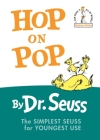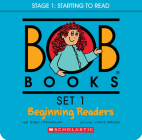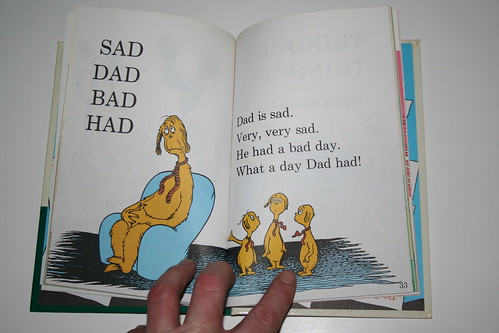I love the Flip-a-Word books! Their publisher is phasing them out this year, which makes me quite unhappy. A week or two ago, I bought up every copy of Snake Cake that I could find from suppliers, but they're going fast. Harriet Ziefert, who wrote the books, is a prolific and wonderful writer on many levels -- we've written about her non-early-reader books here and here.
The classic of this form of early reader has to be Dr. Seuss's
Hop on Pop. It's funny, it's frenetic, and it gets the job done phonetically:
 ALL TALL
ALL TALLWe are all tall.
[pictures of long skinny beings]
ALL SMALL
We are all small.
[pictures of little skinny beings]
Then there's one of the show-stoppers. Excuse the imperfect illustration: my scanner's still on the fritz and this was the best I could find online:
SADDADBADHAD
Dad is sad.Very, very sad.He had a bad day.What a bad day Dad had!
Lots of rhyming, lots of changing only the first consonant of words. And -- very important in the learning-to-read trajectory -- lots of HUMOR! (note who's wearing a tie.)
 We've received a number of comments on the
We've received a number of comments on the Bob Books, which are the 800-pound gorilla of the learning-to-read world. They come in sets: a box with 8 to 12 booklets inside, depending on the reading level. They're very methodical. The first set sticks mostly with three-letter words, all capable of being sounded out. The inside of the cover tells the adult what sounds the book will be presenting.
So for Book 1 of Box 1, the sounds are:
And the text goes like this:M m - moonA a - appleT t - tableS s - sun
Page 1:Some kids will pick up booklet #1 and get it immediately and then just keep charging through the clear presentation of different sounds -- and before they know it they're readers. In my experience, though, this isn't at all universal. Equally as possible is a Deep Boredom reaction. A child will get as far as the second "Sam sat" and walk away from the book. Some of the stories are nothing but non sequiturs, and the sense of humor is thin. For some kids, box #1 is a jumpstart, and they're flying on to anything else they can get their hands on. For others, they'll go through all five boxes before they're ready to explore more random reading choices. As with everything else, you just have to see what your child reacts to.
Mat.Page 2:
Mat sat.Page 3:
Sam.Page 4:
Sam sat.Page 5:
Mat sat. Sam sat.Page 6:
Mat sat on Sam.
I've always had this suspicion that my sister (your mother) is the person who really invented the Bob Books, and that someone more commercially-oriented created the ones that ended up with a copyright and publisher. You mentioned that Eleanor has been practicing reading with some of the books Judy wrote as a reading teacher. They're short, phonetically-oriented booklets, but full of a great sense of humor. My memory of them is that in the days before the internet, she would xerox them and give them out to other teachers who wanted to use them (Judy -- ??). Judy has both a great sense of humor and a lovely, funny artistic talent. I can't reproduce the pictures here, but I will give the full text of The Cat and the Cab, by Judy Thoms. Each line is a new page:
The cat has a cab. [picture: cat driving a cab, complete with little tree-shaped deodorizer]
The cab gets gas.
A man has a bag.
Cab! Cab! [man is flagging cab driven by cat]
The cab gets the man.
The cat gets the bag. [cat putting suitcase in trunk of cab]
Good-bye, cat. Good-bye, man. Good-bye, bag. Good-bye, cab!
Good-bye readers, one and all.
Love,
Deborah


No comments:
Post a Comment